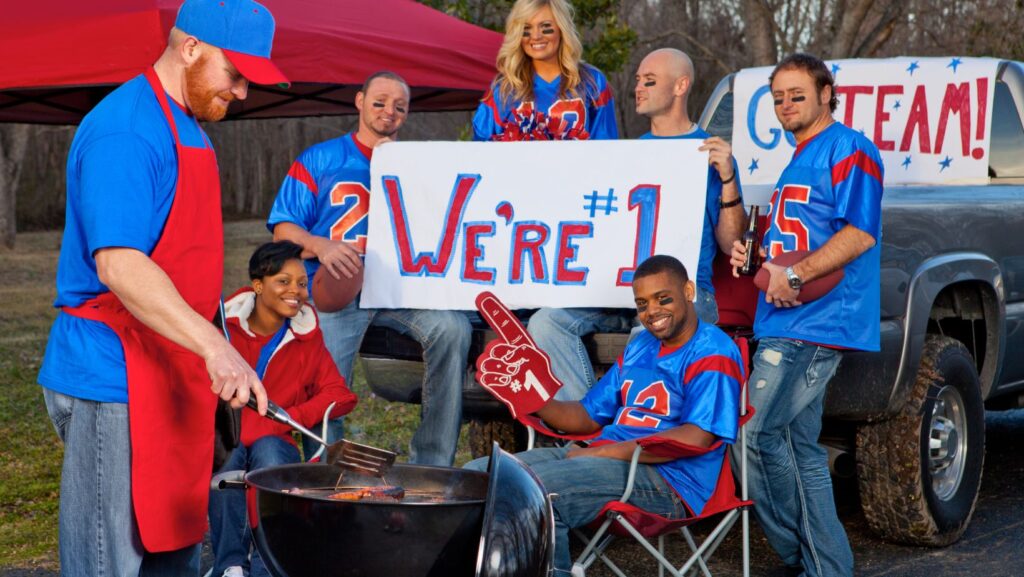
Tailgating plays a pivotal role in American football culture, evolving from a simple pre-match gathering to an essential part of the sports and entertainment experience. Fans of all ages come together to celebrate their teams, share food and drinks, and immerse themselves in the camaraderie that defines this essential tradition.
Origins and Evolution of Tailgating
The origins of tailgating date back to the late 19th century, with some historians tracing its roots to the first college football game between Rutgers and New Jersey (before being named Princeton) in 1869. Fans reportedly gathered to cheer on their teams while enjoying picnics from the backs of horse-drawn carriages. Over the years, tailgating has evolved into a much larger and more organized event, with modern tailgates featuring elaborate set-ups, high-tech grills, and custom decorations. The tradition has become an integral part of game day, transcending the sport itself to become a cultural phenomenon.
The Rituals of Tailgating
The tailgating rituals are a vibrant blend of preparation, celebration, and tradition, bringing fans together through shared experiences of food, fun, and team spirit, transforming stadium and arena parking lots into lively hubs of activity before the big game.
The Set-Up
The tailgating experience begins with the perfect set-up. Fans often arrive hours before kick-off to claim prime parking spots and create a welcoming atmosphere. Vehicles – ranging from trucks to RVs – are decked out with team flags, banners, and themed decorations. Overall, pop-up tents, foldable tables, and comfortable chairs transform parking lots into hubs of activity, while some dedicated fans go the extra mile, bringing portable generators, televisions, and sound systems to enhance the experience.
The Food
Food is a cornerstone of any tailgate. From classic burgers and hot dogs to regional specialities like Texas brisket or New Orleans jambalaya, tailgaters pride themselves on their culinary offerings. Many bring portable grills or smokers to cook on-site, filling the air with distinct mouth-watering aromas.

Potluck-style tailgates are common, with attendees contributing dishes to share with the group, while signature recipes, passed down through generations, become the headline of these pre-match parties.
The Drinks
No tailgate is complete without beverages. Beer is a staple, with many fans opting for craft brews that showcase local flavors. Cocktails, spiked punches, and non-alcoholic options like sodas and sports drinks are also popular. Some tailgaters even set up portable bars, complete with mixers and garnishes, to craft custom drinks. Responsible drinking is emphasized, as tailgaters aim to enjoy the festivities safely.
Games and Entertainment
Games and entertainment are another key component to the celebrations and keep the energy high before kick-off. Popular activities include cornhole, ladder toss, and beer pong, while some groups organize trivia contests or karaoke sessions. Larger tailgates might feature live music, DJs, or themed costume contests. These activities not only pass the time but also foster connections among fans.
Team Spirit and Rivalries
Tailgating is a celebration of team spirit. Fans dress in team colors, paint their faces, and wave banners to show their support. Friendly rivalries add an extra layer of excitement, with fans from opposing teams exchanging good-natured remarks and jokes, predicting the scoreline, and discussing other aspects tied to the sport, such as matched betting strategies. The sense of unity and pride that tailgating fosters is a key reason why it remains such a cherished tradition.
For some fans, tailgating rituals include chants, fight songs, and even superstitions believed to bring luck to their team. These practices create a sense of belonging and deepen the emotional connection to the game. Rivalries, while intense, often lead to memorable interactions and stories shared for years to come.
The Clean-Up
Once the festivities wind down, the clean-up begins. A crucial part of responsible tailgating is ensuring the area is left as pristine as it was found. Organizing a quick clean-up with friends and fellow tailgaters helps keep the environment clean and prevents any fines or penalties from event organizers. It’s important to bring along garbage bags, recycling bins, and even portable vacuums to make the process smoother.
Many tailgaters also adopt a “leave no trace” policy, making sure every bit of trash is collected and disposed of properly. This not only preserves the tailgating tradition for future events but also reflects well on the community of fans, ensuring everyone can continue to enjoy the pre-game festivities.
The Social Aspect of Tailgating
Tailgating brings people together in ways few other events can. It’s an opportunity for family, friends, and strangers to bond over shared interests. The sense of community is palpable as fans welcome newcomers and share stories of past games and moments. Tailgating often extends beyond football, with many groups maintaining friendships that last well beyond the season.
The inclusivity of tailgating is one of its defining features. Regardless of background, occupation, or hometown, fans unite under a shared love for the game. This sense of connection is especially evident during milestone events like playoff games or championship matches, where the energy is unparalleled.
The Impact of Tailgating on American Football
Tailgating has a significant impact on the culture and economy of American football. It enhances the overall game-day experience, drawing in fans who might not even attend the game. The tradition also boosts local economies, with fans purchasing food, drinks, and supplies from nearby businesses. For many, tailgating is as important as the game, cementing its role as a cornerstone of American football culture.
Stadiums and teams have recognized the importance of tailgating, with some venues offering designated tailgating areas and amenities. These investments not only improve the fan experience but also increase attendance and revenue. Tailgating has also inspired charitable initiatives, with fans organizing food drives, fundraisers, and awareness campaigns during game days.
Summary
Tailgating is more than a pre-game activity; it’s a celebration of sports, community, and tradition. From its humble beginnings to its modern-day extravagance, tailgating has become a defining aspect of American football culture. Whether you’re grilling burgers, playing cornhole, or cheering with fellow fans, tailgating offers an unforgettable way to connect with others and celebrate the love of the game.













